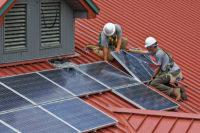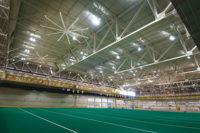Big-box retailers like Wal-Mart, Costco, IKEA, and Kohl’s are widely recognized, and aptly named, for their large, boxy retail stores throughout the country. The amount of energy used to illuminate, heat, cool, and run these buildings is significant, though many companies have been hesitant to look into renewable energy due to the high up-front cost of equipment.
But with the price of photovoltaic (PV) panels falling rapidly — by about 60 percent since the beginning of 2011, according to Thomas Kimbis, vice president of government affairs for the Solar Energy Industries Association (SEIA) — utilizing solar energy has suddenly become a cost-effective choice for many large retailers, who are now embracing the technology with open arms.
Wal-Mart, Costco Lead Way
Wal-Mart is No. 1 on the list of top 20 companies producing on-site solar energy, according to a report from the SEIA. The retail giant has the capacity to produce more than 65 MW of electricity, and according to Wal-Mart’s website, “These locally generated power sources have the potential to meet up to 60 percent of a store’s energy needs.”
The company now has more than 150 solar installations in seven countries, and three-quarters of its California facilities use “some form of renewable energy,” the company said.
Craig Peal, assistant vice president of energy and building controls for Costco Wholesale, said that while the solar panels don’t usually generate enough energy to run the whole building, it is a cost-effective way to help power those facilities. Costco, which holds the No. 2 spot on the list, generates roughly 39 MW of electricity with its solar panels.
“These systems lower the operating costs of the associated facilities,” Peal said, adding that the company, which installed its first PV panels in 2006, now has solar panels on 77 stores and plans to continue installing solar panels on additional stores.
“These are not companies that are known for just making rash business decisions,” Kimbis said. “They’re known for watching every penny and making sure that the decisions they make pencil out. Solar fits into that equation.”
A Smart Investment
For the average large retail store, the rooftop HVAC system accounts for roughly one-quarter of the building’s total electricity consumption and more than three-quarters of the natural gas consumption, making the HVAC system the single largest energy consumer in the building, according to www.energystar.gov. Buildings that utilize solar panels can potentially wipe out the cost of running the heating or air conditioning systems altogether, which is helping to make solar an increasingly enticing option for many companies.
“Traditionally, electricity prices have risen over time, so we’re seeing companies, as they get more and more competitive in the U.S., trying to eliminate any cost they can. They’re trying to extract cost savings from any sector they can and they’re looking very closely at their utility bills,” Kimbis said. “They’re finding they can hedge against future price volatility through solar, and they can also capitalize on an asset they don’t normally use, which is their rooftops.”
The solar industry, Kimbis added, currently employs 119,000 Americans and is continuing to grow. For HVAC contractors, this could present a significant opportunity.
“A great number of those employed are tradesmen,” Kimbis said. “So, it certainly doesn’t hurt for contractors to become educated about potential work that can be gained by installing solar on rooftops.”
Top 20 Solar Companies
According to a November 2012 report from the Solar Energy Industries Association (SEIA), “The top 20 corporate solar users’ installations generate an estimated $47.3 million worth of electricity each year.”
1. Wal-Mart (65,000 kW)
2. Costco Wholesale (38,900 kW)
3. Kohl’s Department Stores (36,474 kW)
4. IKEA (21,495 kW)
5. Macy’s (16,163 kW)
6. McGraw-Hill (14,113 kW)
7. Johnson and Johnson (11,619 kW)
8. Staples Inc. (10,776 kW)
9. Campbell’s Soup (9,900 kW)
10. Walgreen’s Co. (8,163 kW)
11. Bed, Bath & Beyond (7,543 kW)
12. Toys ‘R’ Us (5,676 kW)
13. General Motors (5,630 kW)
14. FedEx Corp. (4,889 kW)
15. White Rose Foods (4,888 kW)
16. Dow Jones & Co. (4,100 kW)
17. Snyder’s (3,500 kW)
18. ProLogis (3,499 kW)
19. Hartz Mountain Industries (3,438 kW)
20. Crayola (3,356 kW)
To view the SEIA’s entire report, visit http://bit.ly/17F1PbO.
Publication date: 6/17/2013
Want more HVAC industry news and information? Join The NEWS on Facebook, Twitter, and LinkedIn today!






